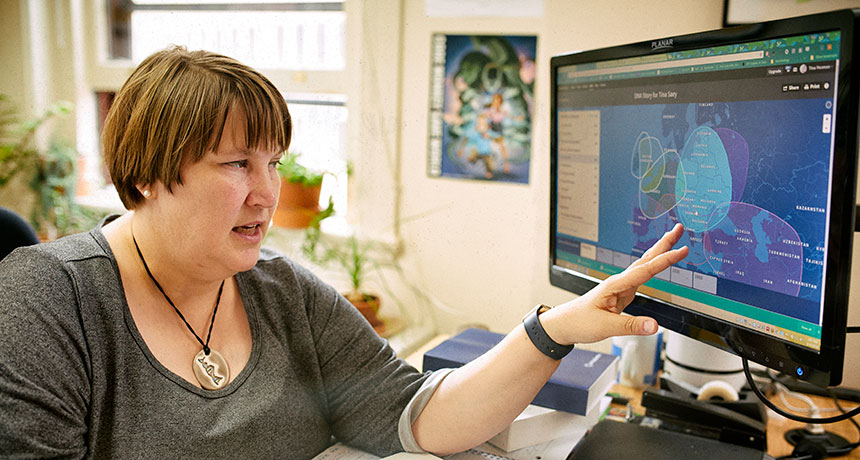Discovering your roots has never been simpler. Genetic genealogy breakthroughs have transformed how we uncover family histories. DNA ancestry testing reveals our ethnic beginnings and links us to unknown relatives. It can also illuminate migration patterns across generations. This scientific journey combines technology with personal discovery. Many find connections that traditional research could never uncover. You can get a DNA kit as you embark on your journey to reveal the story in your genes.
This post discusses how DNA ancestry testing reveals your ethnic roots and connects you to genetic relatives. It covers privacy considerations and data ownership. Additionally, it offers research tips for preserving and sharing your genetic heritage.
Understanding DNA Ancestry Testing
Genetic genealogy has changed how we look at family histories. It does this by examining the unique genetic code we get from our ancestors.
How DNA Testing Works for Genealogy
When you send in a sample, like a cheek swab or saliva, labs pull out your DNA. They check specific markers to analyze them. These genetic markers serve as signposts that indicate both recent and ancient ancestry. The analysis shows patterns tied to specific regions and population groups. This creates a clear view of your genetic makeup.
Types of DNA Tests
Different tests examine different things about your hereditary genetics. Autosomal DNA testing analyzes chromosomes that people obtain from both parents. They yield information about the last 5 to 7 generations. Y-DNA tests examine the Y chromosome, which fathers give to their sons. This traces directly the paternal line. The mtDNA (mitochondrial DNA) testing reveals the maternal lineage of an individual. They examine genetic material passed by mothers to all of their children.
What Genetic Information Can Reveal
DNA analysis uncovers ancestral origins across continents with remarkable detail. Results show percentages of genetic heritage from different regions. This reflects centuries of human migration and cultural exchange. Besides ethnicity, genetic information can provide health insights. However, these insights vary in scope and accuracy based on the testing service.
Starting Your DNA Journey
Like any other project, your DNA journey requires some careful planning. This helps you get the most from your results.
Choosing the Right DNA Test for Your Goals
Consider what you hope to discover before selecting a test. An autosomal test is great for anyone wanting a broad view of their ethnic heritage. If you’re studying paternal lineage, you need Y-DNA testing. For maternal lines, look into mtDNA options. Research enthusiasts often combine multiple test types for comprehensive results.
What to Expect in Your DNA Results
Initial results typically arrive 4-8 weeks after submitting your sample. Most reports show ethnicity estimates with percentage breakdowns by region. They also provide lists of possible relatives who have tested. Plus, they include raw data files for more analysis. You can get a DNA kit. It provides regular updates as databases grow and analysis methods get better.
Privacy Considerations and Data Ownership
Before testing, review privacy policies carefully. Most companies store your genetic information indefinitely unless you request deletion. Think about who owns your DNA data. Will it be shared with research partners or law enforcement? Also, what control do you have over how it’s used? Each service provides different levels of user privacy management features. Some reputable ones let you choose to opt out of research or relative matching.
Interpreting Your Ethnicity Estimates
Ethnicity results can be exciting, but you need to understand them well to interpret them correctly.
The Science Behind Population References
Ancestry percentages rely on reference populations. These are groups with strong ties to certain areas. Your DNA is matched to these references to show where your ancestors likely lived. The accuracy of results relies on the quality and diversity of these panels. This is especially true for regions and populations that are less represented.
Accuracy and Limitations of Ethnicity Predictions
Continental-level ethnicity results provide the best degree of accuracy when testing DNA. They lose precision when trying to differentiate between nearby regions. Results represent statistical probabilities rather than exact measurements.
Siblings who fall under the same ancestral lines might discover considerable differences in their test results. This shows how random genetic inheritance can be. Many companies refine their estimates periodically as reference populations expand.
Connecting with Genetic Relatives
For many people, finding unknown relatives is the best part of DNA testing.
Understanding DNA Matching Systems
Testing companies identify potential relatives by comparing segments of shared DNA. The shared amount shows the likely relationship. Parents and children share about 50%. First cousins share around 12.5%. More distant relationships share even less. Match lists usually show estimated relationships and ways to connect with genetic relatives.
Building Your Family Tree with DNA Evidence
DNA matches can confirm suspected relationships and breakthrough research roadblocks. Genetic connections boost the accuracy of family trees when used with traditional records. This process often reveals family stories that might stay hidden. It’s especially valuable for adoptees and people with unknown parentage.
Managing Unexpected Discoveries
DNA testing sometimes reveals family secrets, from unexpected siblings to mistaken parentage. You must get ready for surprises. Develop emotional resilience to deal with sensitive situations by being kind in your approach. Genetic ties are only one part of family relationships. Also, discoveries can impact many people, not just you.
Beyond Basic Results: Advanced Genetic Genealogy
Many researchers move beyond initial reports into more sophisticated analytical techniques.
Chromosome Mapping
Advanced genetic genealogists use chromosome mapping to track DNA segments from specific ancestors. This visual tool shows which parts of your genome come from certain family lines. It enables researchers to build extended family connections and enhance conventional documentation.
Using Raw DNA Data for Deeper Research
The majority of genetic testing companies provide access to your raw genetic information for download. You can use third-party tools for analysis. These tools offer extra insights about your ethnicity, health, and matching capabilities. Many researchers upload their data to several platforms. This helps them access different reference populations and matching databases.
Combining Traditional and Genetic Research Methods
The best genealogical discoveries occur when documents and DNA work together. DNA can hint at relationships that documents can confirm. At the same time, historical records give context to genetic links. This combined method offers a deeper view of family history than either approach alone. Together, they help you build your family tree with accuracy and personal meaning.
Next Steps in Your Ancestral Journey
DNA testing marks the beginning rather than the end of most genealogical journeys.
Joining Genetic Genealogy Communities
You can connect with fellow researchers on virtual forums as well as social media sites and local genealogical communities. These communities can help you understand tough results and deal with research challenges. Many experienced members love to share their knowledge. They help newcomers as they make their first DNA discoveries.
Resources for Further Learning
Numerous books, websites, webinars, and courses can deepen your understanding of genetic genealogy. Start by studying beginner materials that will teach you essential ideas. Specialized topics become suitable when your understanding progresses. Regular practice analyzing your results helps build competence in this complex field.
Preserving Your Family’s Genetic Legacy
Test older generations when possible. They carry genetic information that may otherwise be lost. Document your discoveries systematically. Share findings with interested relatives. This creates a lasting knowledge legacy about your shared heritage.
Conclusion
DNA testing offers a new window into our past ancestors. It enhances historical research with molecular data. The discipline keeps evolving as technology advances. Whether validating family legend or fulfilling curiosity, genetic genealogy offers powerful tools for discovery. Your results will uncover secrets about your ancestors’ travels through generations and continents.




